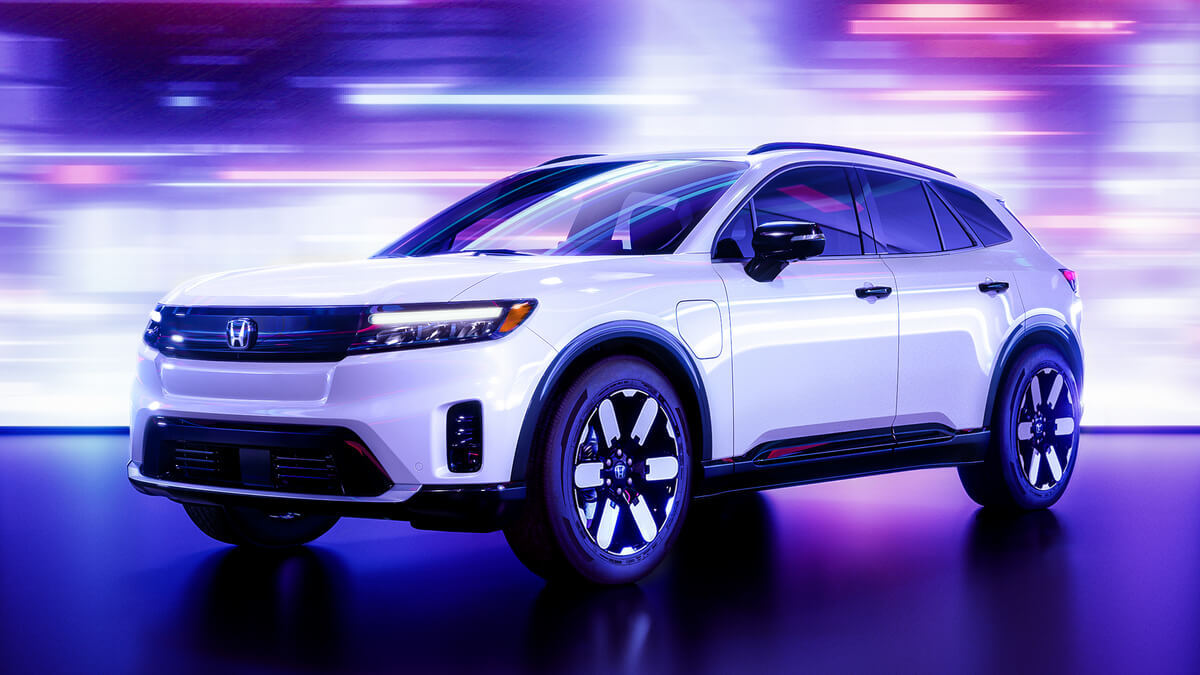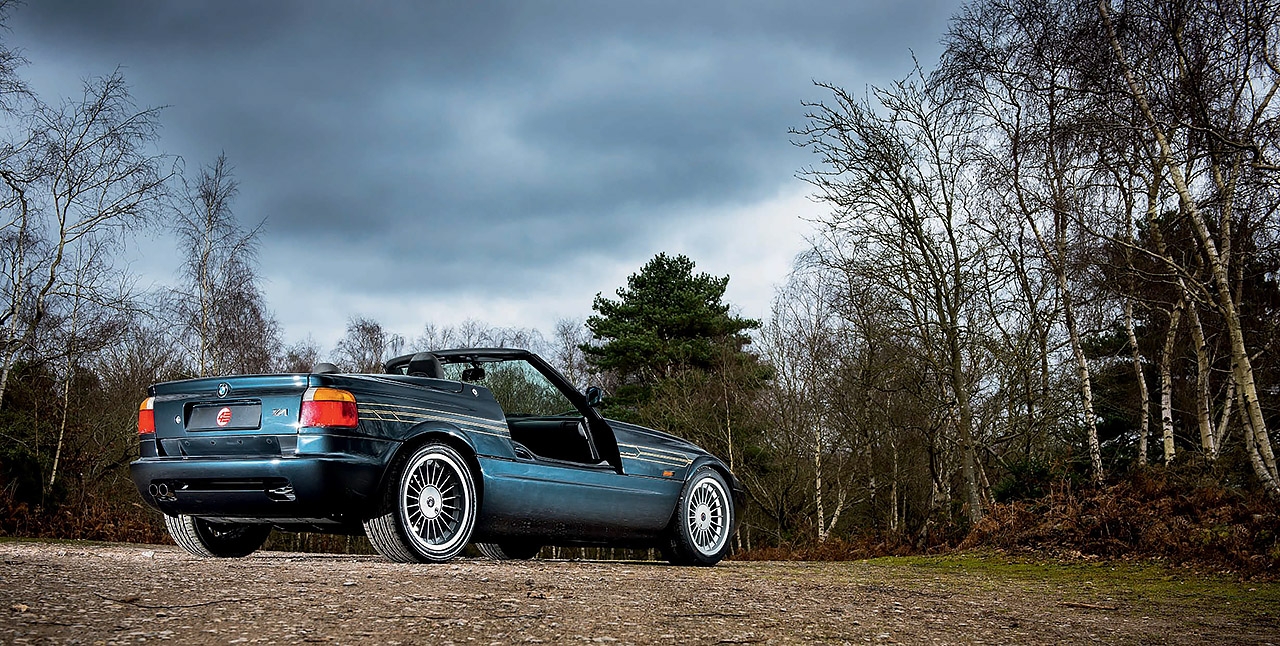
Mythical Beast The Z1 is an icon in itself but this very rare Alpina RLE version reaches a whole new level. The Z1 is a pretty rare beast in its own right but the Alpina version, the Roadster Limited Edition, ranks almost as high as the unicorn in the rarity stakes with just 66 examples manufactured Words: Bob Harper Photography: Dave Smith.
There’s something about the Z1 that’s just utterly mesmerising. As you’d expect we’ve driven our fair share of them over the years, from BMW UK’s heritage car to several belonging to our publisher as well as various modified examples with all manner of engines. And the one thing all these Z1s have had in common has been their ability to drop jaws, set tongues wagging and fingers pointing. And our recent trip out in this delightful Dream black example that’s up for sale at 4 Star Classics was no exception.
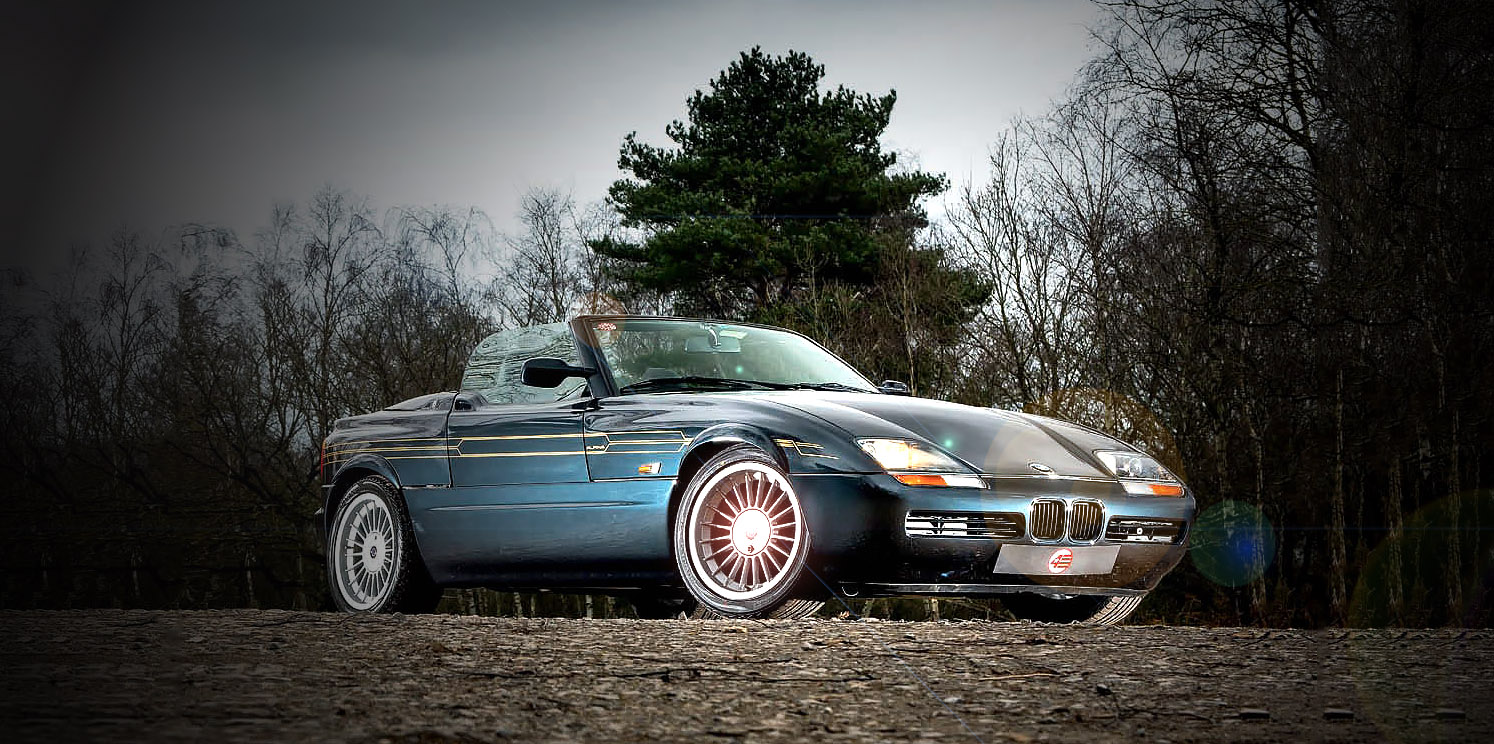
You can hear the sonorous straight-six singing away to itself and the slick five-speed ’box enables you to play a decent set of tunes.
On a dark and dour day with heavy clouds virtually the same colour as the car threatening to deposit their load on to the freshly polished machine, ‘our’ Z1 had the desired effect as we dawdled for two miles from 4 Star’s HQ to the nearest petrol station with the fuel gauge’s needle being brightly illuminated in the diminutive dial by the amber low fuel light. Lorry drivers towering above us swivel their necks to get a second look as we burble past and even the coolest of dudes passing the other way in some sort of Audi with LED lights blazing gives a thumbs up. Yup, the Z1 exudes a certain type of feel-good factor, but it probably doesn’t do to drive one if you are a bit of a shrinking violet.
As if any further proof was required as to the Z1’s traffic-stopping ability, our stop for a splash and dash at the first petrol station we come across demonstrates it perfectly. There’s a hand car wash situated on the forecourt and a guy is expertly hosing down a car with the high-pressure washer when his gaze turns from the task in hand as the Z1 pulls on to the forecourt. His mind wanders further from car washing as he witnesses the Z1’s driver’s door window drop into the door as the door seamlessly drops into the sill and he’s only awoken from his Z1 daydream by his colleague who is being soaked by the now forgotten and misdirected pressure washer lance. Highly amusing.
As well as the Z1’s door-dropping party piece there’s something about the car that’s so un-BMW that you almost wonder why the design was given the green light for production. There’s no Hofmeister kink (to be fair, there rarely is on a convertible) but the headlights didn’t have the traditional four round units and the kidney grilles didn’t exactly look BMWesque either. These days we have got used to kidneys in all shapes and sizes but back in the late 1980s their design was pretty set in stone and they were always chrome. The Z1’s body was made out of plastic, it had a separate backbone chassis and the door mirrors jutting out from the A pillars haven’t really been replicated either before or since. In short, it was a unique piece of BMW design. Brave and incredibly forward thinking.

While the Z1 was lauded on its arrival for its looks, charm and chassis, the one area where it was criticised was for its comparative lack of grunt. Not that there was anything desperately wrong with the M20 straight-six that had been borrowed from the E30 325i it was just that the chassis felt like it was capable of handling so much more. Where the E30 with its semi-trailing arm rear suspension could feel like a bit of a handful, the Z1 with its multi-link Z-axle (that went on to feature in the E36 3 Series) just felt utterly planted and it didn’t take long before Europe’s tuning houses went to work on the car. Perhaps the most successful approach was by Mosselman with its turbo conversion for the car which we drove back in 2009 and in more recent times the car has still attracted attention from the modifiers and we’ve driven ones with fettled M20s along with M3 sixcylinder power and even one packing an M5’s V8.
However, there was only one version made by BMW and more or less the only thing you had to decide when ordering your Z1 was which colour to choose. For a few favoured customers, though, Alpina also made a Z1, and it’s that car you can see before you here. Known as the Alpina RLE (with the acronym standing for Roadster Limited Edition) it was one of the rarest of modern day Alpinas with officially just 66 examples being constructed, half of which were destined for export to Japan – a country that’s very, very keen on bespoke products from Buchloe.
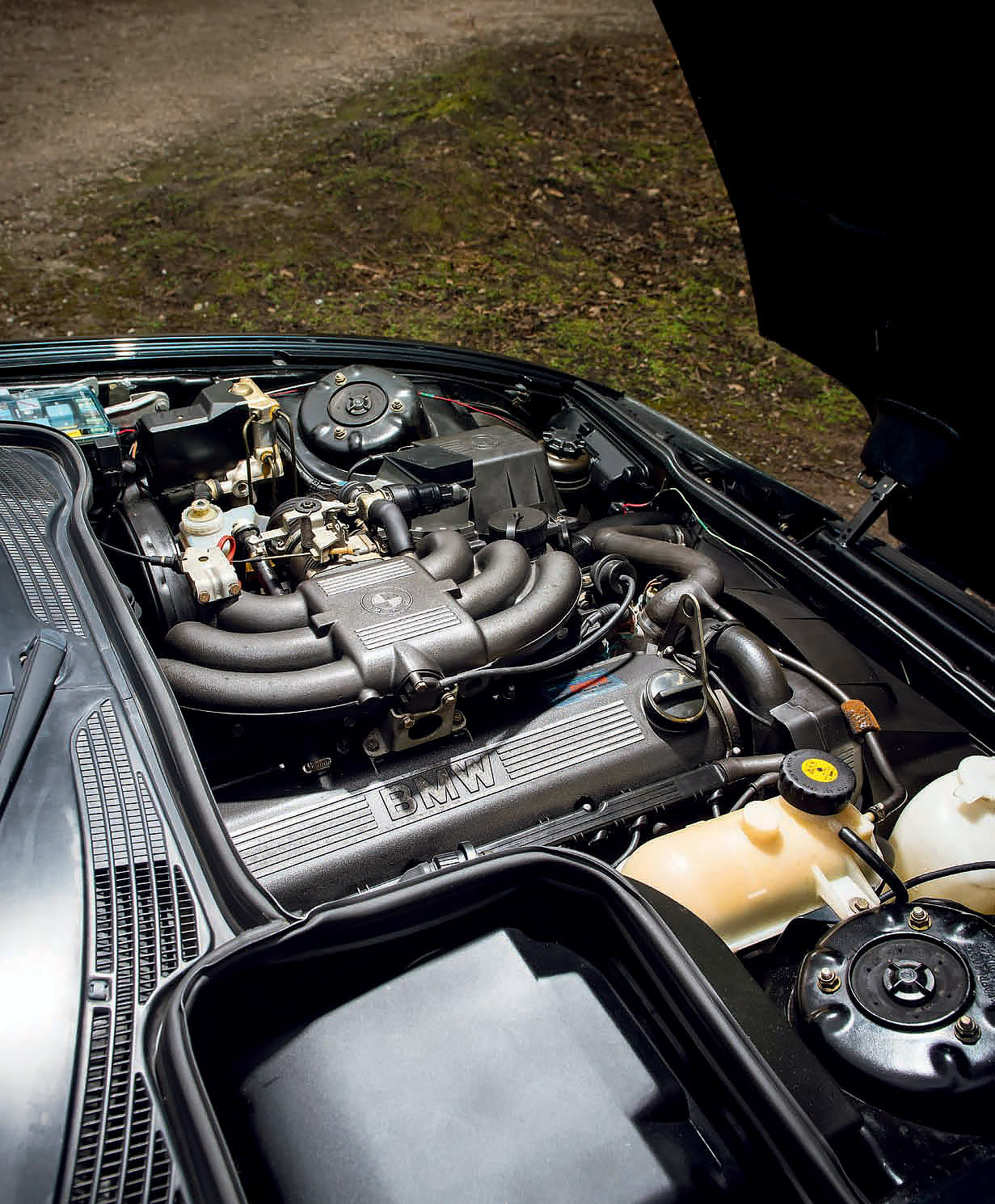
As Alpina had the perfect engine sitting on the shelf for the Z1 it made perfect sense to drop in its version of the M20 ’six in 2.7-litre form.
By the time the Z1 came along in the late 1980s Alpina’s set of upgrades for a BMW were pretty well set in stone and you could bet your bottom dollar that any given BMW would be subjected to a thoroughly comprehensive makeover prior to being signed off by Alpina’s boffins and receiving the coveted production plaque. Engines would be handbuilt at its Buchloe HQ, the traditional Alpina aerokit would be in place and you’d just know that it had been designed first and foremost with aerodynamics in mind with aesthetics coming in second place. Suspensions would be altered, seemingly offering a much better blend of ride/handling and comfort than you would find in either the contemporary BMW or M car and to set everything off you’d find a set of Alpina Classic alloys shod with tyres that would have been tailored to the car’s chassis or vice versa. These were the days of such comprehensively altered machinery as the iconic B10 Bi-Turbo, a car that was lauded for a time as the world’s fastest four-door production car.
And with this in mind it hardly seems possible that Alpina’s work on the Z1 was so minimal. Part of the reason for this is that as a pretty bespoke design BMW got it virtually spot on with the Z1 from the outset which left Alpina with less to do when manufacturing the RLE. Alpina traditionally had to give BMWs a bit of a helping hand on the aerodynamic front, especially as with more power they tended to be a fair bit faster than their BMW production counterparts but with the RLE, Alpina wisely decided not to try and improve upon the original design. The low nose, flat floor and very clever rear exhaust box which helped to generate downforce at the rear as air flowed over it ensured that Alpina didn’t need to change the car’s aerodynamics so it left well alone and instead concentrated on improving the Z1 where it mattered most – the engine.

Inside is remarkably untouched for an Alpina with only a few choice additions in place instead of the usual complete retrim with the blue and green stitching we’re used to seeing.
No doubt there must have been the odd conversation in Buchloe aimed at making the Z1 a real performer but shoehorning one of the company’s larger straight-sixes into the engine bay would have severely upset the handling balance and as Alpina had the perfect engine sitting on the shelf for the Z1 it made perfect sense to drop in its version of the M20 ‘six in 2.7-litre form as used in the E30 C2 and B3 2.7. Once the M20 had had its capacity increased to 2651cc and had been fitted with a slightly more aggressive camshaft it was good for up to 204hp in E30 guise although for the Z1 it was rated at 200hp as its exhaust was ever-so-slightly more restricted. To back up the 200hp at 6000rpm there was 193lb ft of torque at 4800rpm and these figures were enough to really raise the Z1’s game in the performance stakes with 0-62mph now taking just 7.1 seconds while its 0-100mph time had dropped to 17.8 seconds. That might not be anything to write home about these days but back in its day the standard Z1 could only muster an 8.4 second 0-62mph time and its 0-100 time was a very leisurely 23 seconds. For those who intended trying to hog the outside lane on the Autobahn the RLE’s top speed was now 142mph, up from 136mph.
Other changes were exceptionally minimal. The Z1’s suspension was deemed to be well suited to the car and rather than installing one of its bespoke setups all Alpina did was to swap the standard front springs for slightly shorter items. Over the years, Alpina had also become famous for its interior upgrades – hip-hugging seats clad in its trademark blue and green striped cloth was a common upgrade in the 1980s, but once again Alpina decided against going wild with the Z1’s cockpit, relying on the standard BMW seats and trim instead. There was a bespoke Alpina steering wheel with the company’s trademark stitching and in the centre of the steering wheel boss was an Alpina logo with the famous carbs and crankshaft symbols and around the edge it bore the words ‘Limited Edition’ and the car’s production number — in our case 54/66. There’s also a production plaque behind the gear lever which eschews the normal black oblong style as this one’s more or less square and made of silver metal.
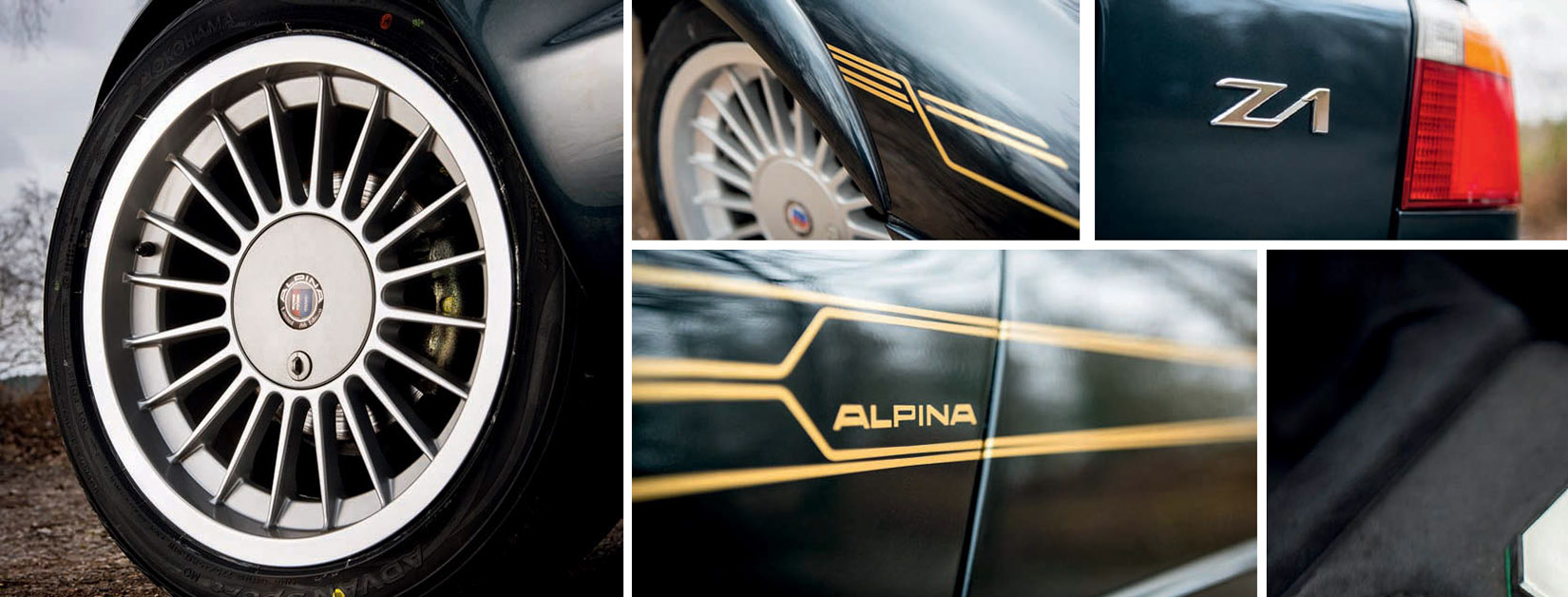
All Japanese specification examples of the Alpina RLE came fitted with these arch extensions in place to cover the larger wheels. The Alpina Classic wheels actually feature centre caps individual to each particular build number, in this case 54 of just 66. The build number also features in the centre console plaque, steering wheel and key fob.
The RLE package was finished off with a set of trademark Alpina alloys measuring 8×17-inches, an inch up in diameter from the standard Z1 items and the wheels were shod with 235/45 Michelin MXX3 rubber. In the centre of each wheel was an Alpina logo that mirrored the one on the steering wheel in that they bore the car’s production number. This was unique to the RLE with no other Alpina extending the production number to the wheel centres. Even the key fob bore the production number!
That’s enough on the history front though, what we want to discover now is what the Z1 is like to drive today. Does the extra oomph offered by Alpina endow the car with enough power to bring the chassis alive? Once we’ve fuel on board and we’ve stopped sniggering at the antics of the car wash boys we head off in search of some decent driving roads on the way to our photo location and we’re immediately struck by several thoughts. Compared to modern machinery the Z1 really does feel small — it’s over 30cm shorter than the current Z4 and it feels narrow too, and compared with a modern machine there’s little in the way of space to store your oddments bar a small cubby next to the handbrake. You feel low and the dark cockpit on this dour day makes it feel claustrophobic with the hood raised. Slow, pockmarked side roads aren’t its forte with the ride feeling a little lumper than what we expected.

Eventually we emerge on to some wider, more open A roads and with the rain still being held at bay we decide to pull over and drop the hood to get the full Z1 experience. Entry and egress with the roof in place isn’t the easiest of manoeuvres especially if you’re an old man with a dodgy back, but once the simple manually folded hood is dropped under its rear deck cover hopping in and out is much easier and the RLE starts to come alive. Driving with the doors down is a bit of a hoot, but you feel really exposed and at anything much above walking pace there’s tremendous buffeting from the wind. You’re better off raising the doors and windows and driving thus the Z1 feels remarkably snug. You can hear the sonorous straight-six singing away to itself and the slick five-speed ‘box enables you to play a decent set of tunes through the bespoke Alpina exhaust. As speeds rise the suspension that seemed a little uncompromising earlier has smoothed out and even in these cold and damp conditions there’s plenty of grip but we don’t push too hard partly in deference to the car’s value — 4 Star has it up for sale for a fiver shy of £70k!
And that high price might be a stumbling block as far as we’re concerned. RLEs hardly ever come up for sale with most of them snuck away in collections so this is around what we’d expect to pay for an Alpina Z1 in good condition, but at this point the car’s almost too expensive to be enjoyed unless money really is no object. Wouldn’t you be better off buying a ‘regular’ Z1 for a third of this and actually be able to enjoy driving it, and give other folk the pleasure of seeing one on the road? The Z1 in all its forms is still a mesmerising machine and with the RLE Alpina endowed it with just about enough go to accompany the show, but despite its obvious charms we reckon we’d be more than happy with a standard example even if it might feel a little lacking in oomph when compared to the Alpina.
| Car | Alpina-RLE BMW Z1 based (BMW-Alpina RLE – Roadster Limited Edition) |
| Made in | Germany |
| Produced: | 1989–1991 |
| Number built | 66 |
| Engine: | BMW M20 B25 straight-six based Alpina C2/6, 12-valve 6-cylinder-inline engine (four-stroke), front-mounted |
| Bore x Stroke: | 88 mm × 77 mm (3.4 in × 3.1 in) |
| Displacement: | 2,651 cc |
| Max. Power @ rpm: | 200 bhp @ 6000 rpm |
| Max. Torque @ rpm: | 193lb ft @ 4800rpm |
| Compression Ratio: | 9.0:1 |
| Fuel feed: | Electronic fuel injection, Bosch Motronic |
| Fuel tank capacity: | 57-litres (15.1 US gal; 12.5 imp gal) |
| Valvetrain: | SOHC, toothed belt |
| Cooling: | Water |
| Gearbox: | 5-speed manual |
| rear wheel drive, axle ratio 3.64:1 | |
| Electrical system: | 12 volt |
| Front suspension: | McPherson axle, coil springs, stabilising bar |
| Rear suspension:: | Lower trailing arms with diagonal rods, upper wishbones, coil springs, stabilising bar |
| Brakes: | Disc brakes, power assisted, ABS |
| Steering: | Rack and pinion steering, power assisted |
| Body structure: | Plastic body panels on unibody steel chassis with glued-in lower tub |
| Dry weight: | 1,250 kg (2,800 lb) |
| Loaded weight: | 1,460 kg (3,220 lb) |
| Track front/ | 1,456 mm (57.3 in) |
| rear: | 1,470 mm (58 in) |
| Wheelbase: | 2,450 mm (96 in) |
| Length: | 3,925 mm (154.5 in) |
| Width: | 1,690 mm (67 in) |
| Height: | 1,248 mm (49.1 in) (with roof erected: 1,277 mm (50.3 in) |
| Tyre/Tire sizes: | 8×17-inch Alpina Classic – 235/40 ZR17 Michelin MXX3 |
| Top speed: | 235 km/h (142 mph) |
| 0-60 mph | 7.1 sec |
| 0-100 mph | 17.8 sec |
| Fuel Consumption (estimate): | 12.0 litres per 100 kilometres (25 mpg-imp; 20.1 mpg-US) |

